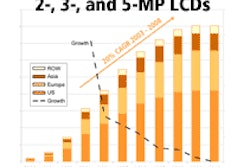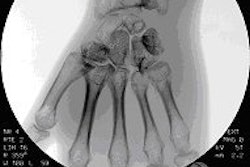SCOTTSDALE, AZ - Although producing an image with computed radiography (CR) takes longer than an equivalent image with direct radiography (DR), CR is still more cost-effective than DR, according to a presentation Sunday at the Digital X-Ray and PACS forum.
"Continuous (patient) flow models are not realistic when performing CR/DR economic analysis," said Dr. Bruce Reiner from the Maryland Institute of Medical Informatics at the University of Maryland School of Medicine in Baltimore.
Reiner presented preliminary results of his group's productivity and workflow analysis. For their research they used Poisson distribution, a probability mass function used to model the number of events occurring within a given time interval. The Poisson model was used to calculate patient arrival rates more accurately than a standard continuous flow model, Reiner said.
The team made an assumption of operation hours of Monday through Friday, from 7 a.m. to 5 p.m. The hours of operation approximated those of a freestanding diagnostic imaging center, as well as those of a hospital-based outpatient imaging clinic, Reiner noted.
The group determined CR and DR exam room capacities on the basis of existing exam volumes and productivity data. To define room capacity, the group established a theoretical number of exams per room per day on the basis of time-motion data. For room occupancy, the team divided the actual number of exams per room per day by the theoretical room capacity.
Four sites in the U.S. participated in the study: Memorial Sloan Kettering Cancer Center in New York City; the Lahey Clinic in Burlington, MA; the Westchester Medical Center in Westchester, NY; and the Baltimore VA Medical Center in Baltimore. According to Reiner, the group examined four different deployments of the CR and DR technology at the institutions:
- Dedicated chest DR compared with dedicated cassetteless CR
- Dedicated chest DR compared with in-room CR
- Multifunctional DR compared with in-room CR
- Multifunctional DR compared with centralized CR
All four study sites performed chest CR and DR exams. Two of the sites also performed CR and DR studies of the abdomen, pelvis, extremities, and spine.
The team estimated the cost per exam room for a multiroom CR with a shared plate reader at $65,000, a single-room CR with an in-room plate reader at $85,000, a cassetteless CR at $250,000, a charge-coupled device (CCD) DR device at $320,000, and an amorphous silicon or selenium DR device at $380,000 to $450,000, Reiner said.
Using the Poisson model for patient arrival, the researchers calculated a daily exam capacity per room of 95 exams per day for CR and 172 exams per day for DR. The group determined the time per exam on the basis of four elements: preparation time, positioning time, exposure time, and postacquisition processing. The postacquisition processing element was further broken down into three areas: image manipulation, image transfer, and cassette transport (for CR).
They found that the total time difference between DR and CR ranged from 104.5 seconds per exam to 221.6 seconds per exam, with more than 60% of the time difference accounted for by CR postacquisition processing.
Reiner noted that changes in postacquisition quality assurance (QA) workflow in CR, with tools such as automated QA, could have a dramatic impact on the productivity of the modality.
The group also compared current room volumes with theoretical room capacities for both CR and DR. They found that the current unused CR capacity at the study sites was between 64% and 76%, and that the unused DR capacity was between 76% and 89.9%.
The researchers then calculated the exam volume and distribution required of a site for an inflection point where DR would become more cost-effective than CR. Reiner said that they assumed an acceptable patient wait time of less than an hour, a mean patient arrival distribution of five patients per hour per exam room, and an equipment lifetime of 10 years with an annual interest rate of 3%.
Reiner said that the researchers found the CR/DR inflection point at a mean patient arrival distribution of 13.5 patients per hour. This translates to 135 patients per room per day, which he said would be 96.8% of capacity of the CR system at the measured site.
"In order to cost-justify DR, extremely high patient volumes are required that approach or exceed CR room capacity," Reiner said. "In reality, most institutions have existing CR room occupancies well below capacity. In the current practice environment, CR is far more cost-effective than DR. This is largely due to the relative imbalance between productivity gains (of DR) and reduced pricing (of CR)."
By Jonathan S. Batchelor
AuntMinnie.com staff writer
February 28, 2005
Related Reading
Report finds vendors enable excess radiation doses in pediatric CR, DR, February 4, 2005
Study compares eight digital x-ray systems in clinical setting, December 24, 2004
Computed radiography's (not so surprising) resilience, September 16, 2004
DR looks good in CR, film comparison study, September 19, 2003
CR and DR cross swords in RT productivity debate, May 3, 2002
Copyright © 2005 AuntMinnie.com



















